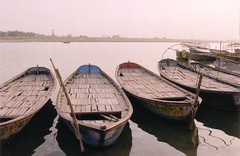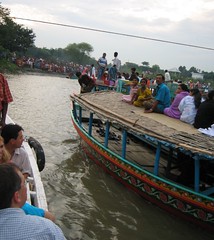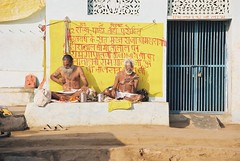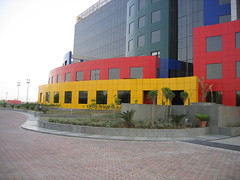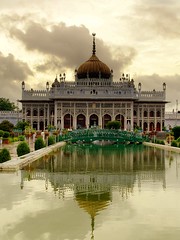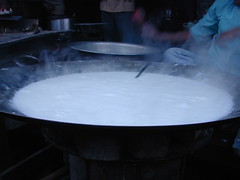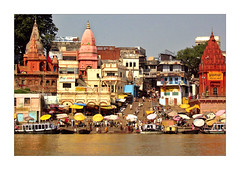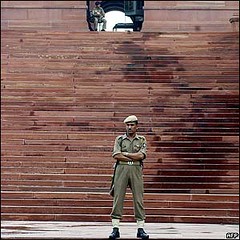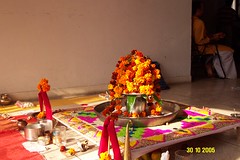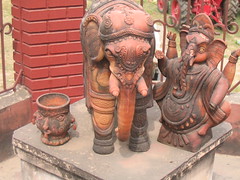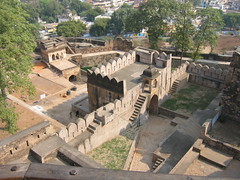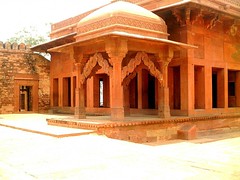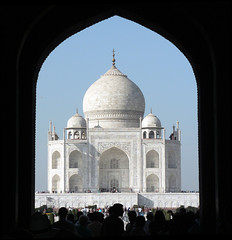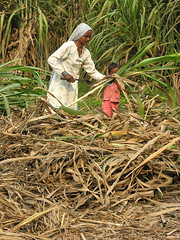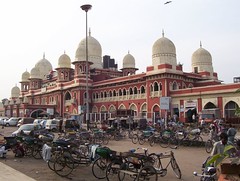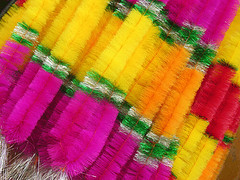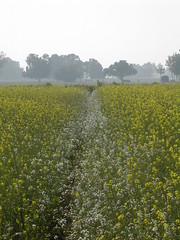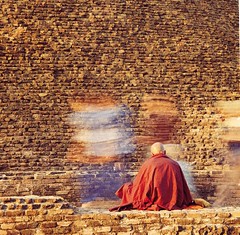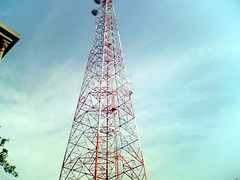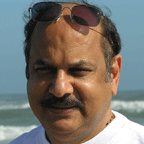Wednesday, October 04, 2006
The holy city of Prayaga was renamed as Illahabad in 1575 by Mughal Emperor Akbar. Eventually, it came to be known as Allahabad. It is also one of the sites of the Kumbha Mela. Allahabad is better known for Sangam, the meeting place of three holy rivers, Ganga, Yamuna and the invisible Sarasvati.
Mirzapur, Uttar Pradesh
Named after the goddess Parvati (Girija) this town was named Girzapur. The town was founded by Raja Nanner as Girijapur, was later changed to Mirzapur.
The main business in Mirzapur is carpet manufacturing.
The main business in Mirzapur is carpet manufacturing.
Moradabad, Uttar Pradesh
This city in Uttar Pradesh was established in 1,600 AD by Murad, the son of the Mughal Emperor Shahjahan. Moradabad has a population of close to a million people and is famous for its huge export of brass handicrafts.
Chitrakoot, Uttar Pradesh
Chitrakoot Dham is one of the most important pilgrimages from Hindu mythology. It is believed to be the abode of Lord Rama, his wife Sita and brother Lakshman for eleven years of their fourteen years in exile. This is the place where Goswami Tulsidas, the creater of the epic "Shri Ramcharitmanas", spent many years of his life.
Noida, Uttar Pradesh
Looking back, probably something good came out of the infamous Emergency Excesses (1975 - 1977). Sanjay Gandhi set up the New Okhla Industrial Development Authority (NOIDA) as part of a major urbanization initiative. Noida came into existence in April of 1976 and is a Department of the Government of Uttar Pradesh.
Noida is a separate administrative zone and a separate district called Gautam Budh Nagar. It has a population of more than 500,000 people. Noida is a highly industrialized city and is considered to be one of the more modernized suburb districts of Uttar Pradesh.
Noida is a separate administrative zone and a separate district called Gautam Budh Nagar. It has a population of more than 500,000 people. Noida is a highly industrialized city and is considered to be one of the more modernized suburb districts of Uttar Pradesh.
Lucknow, Uttar Pradesh
Lucknow (Lakhanpur) was the territory given to Lakshman by his brother Lord Rama and was named as Lakshmanpur. It was part of the Ayodhya Kingdom ruled by the Kosalas.
The city became the capital of Awadh under the Nawabs. The architectural contributions of the Awadh rulers include some of the finest monuments standing today.
The city became the capital of Awadh under the Nawabs. The architectural contributions of the Awadh rulers include some of the finest monuments standing today.
Bareilly, Uttar Pradesh
"Jhumka gira re - Bareilly ke bazaar mein", who can forget the super hit hindi song from Bollywood film - Mera Saaya? Besides, former Miss World and current film heroine Priyanka Chopra hails from Bareilly.
This land of Rohillas was also a part of Panchal Kingdom. The city was built by Mukrand Rai in 1657. Bareilly has a population of 725,000 people and is a fast-growing city. It is also known as 'Baans-Bareilly' because of its large bamboo (Baans) market.
This land of Rohillas was also a part of Panchal Kingdom. The city was built by Mukrand Rai in 1657. Bareilly has a population of 725,000 people and is a fast-growing city. It is also known as 'Baans-Bareilly' because of its large bamboo (Baans) market.
Varanasi, Uttar Pradesh
Varanasi or Benares, is the oldest continually inhabited city in the world. This holy city, situated on the banks of Ganga (Ganges River) in the state of Uttar Pradesh, has a population of more than 1.2 million people.
Varanasi, also known as Kashi has been a cultural and religious center in northern India for thousands of years. The city has produced prominent literary figures and world renowned musicians like Pandit Ravi Shankar and Ustad Bismillah Khan.
Varanasi, also known as Kashi has been a cultural and religious center in northern India for thousands of years. The city has produced prominent literary figures and world renowned musicians like Pandit Ravi Shankar and Ustad Bismillah Khan.
Ayodhya, Uttar Pradesh
The ancient capital of Awadh, Ayodhya was also the birthplace of Lord Rama, the son of king Dasaratha. Ram Janmabhoomi is believed to be the site of the demolished Babri Masjid.
Ghaziabad, Uttar Pradesh
The founder of the city was emperor Ghazi-ud-din. In 1740, he called the city Ghaziuddinnagar. Later the name was simplified to Ghaziabad.
Ghaziabad is now an important industrial city, close to Delhi and Meerut. it is home to a railway coach factory and diesel engines.
Ghaziabad is now an important industrial city, close to Delhi and Meerut. it is home to a railway coach factory and diesel engines.
Jhansi, Uttar Pradesh
The walled city grew around its stone fort as part of the Bundelkhand region. Jhansi is also a major railway junction but it is mainly famous for Rani Lakshmi Bai (Jhansi Ki Rani).
In 1853, the Raja of Jhansi died childless and his territory was annexed by the British. The widow of the Raja, Rani Lakshmi Bai, protested the annexation because she was not allowed to adopt an heir. The Revolt of 1857 found Jhansi ripe for rebellion.
The Rani put herself at the head of native infantry and died bravely in the battle in Gwalior.
In 1853, the Raja of Jhansi died childless and his territory was annexed by the British. The widow of the Raja, Rani Lakshmi Bai, protested the annexation because she was not allowed to adopt an heir. The Revolt of 1857 found Jhansi ripe for rebellion.
The Rani put herself at the head of native infantry and died bravely in the battle in Gwalior.
Fatehpur Sikri, Uttar Pradesh
Akbar, the greatest of all Mughal Emperors, visited the hamlet of Sikri to take the blessings of Sufi Saint Salim Chisti for the birth of an heir. Akbar was blessed with a son and he named him Salim (Jahangir).
Akbar decided to shift his capital to Agra and the new city of Fatehpur Sikri, built on a ridge, grew into a magnificent township. Akbar did not stay in this city for long because of political reasons.
Akbar decided to shift his capital to Agra and the new city of Fatehpur Sikri, built on a ridge, grew into a magnificent township. Akbar did not stay in this city for long because of political reasons.
Agra (Taj Mahal), Uttar Pradesh
Once the capital of India during the reign of Mughals, Agra has a lot more to offer. The Agra Fort was constructed between 1556 and 1605. The construction of the fort was started by Akbar the great but was completed by Shah Jahan who built the world famous Taj Mahal.
Muzaffarnagar, Uttar Pradesh
The population of Muzaffarnagar was 331,000 as per 2001 census. The city was a major producer of sugar, paper and steel. Gur (Jaggery) market in Muzaffarnagar is the biggest in the country. Sugar cane farming is the mainstay of this area with a high per capita income.
Mathura, Uttar Pradesh
The focal point of Brijbhoomi, Mathura is the birth place of Lord Krishna. Situated on the western bank of Yamuna, this city is an important place of pilgrimage.
Mathura was a major metropolis during the time of Buddha in the fifth century BC. The city was also a strategic center for trade and commerce. During the rule of Kushanas, Mathura saw its 'golden age'. The city was also the center of power during the rule of Guptas.
Mathura was a major metropolis during the time of Buddha in the fifth century BC. The city was also a strategic center for trade and commerce. During the rule of Kushanas, Mathura saw its 'golden age'. The city was also the center of power during the rule of Guptas.
Firozabad, Uttar Pradesh
The city of glass, where every second vehicle on the road is fully loaded with glittering bangles of vivid colors. Firozabad is located in the north central India, in western Uttar Pradesh.
Firozabad was known as Chandwar Nagar in ancient times. The name Firozabad was given in the regime of Akbar by Firoz Shah Mansab Dar in 1566.
Firozabad was known as Chandwar Nagar in ancient times. The name Firozabad was given in the regime of Akbar by Firoz Shah Mansab Dar in 1566.
Kanpur, Uttar Pradesh
Kanpur (Cawnpore during the British rule), was the most important industrial center of North India. Kanpur is located on the banks of Ganga. Indian Institute of Technology (IIT) is the most well known educational institution of the city.
Kanpur was taken over by the British in 1801 and it became one of the most important military centers of British India.
Kanpur was taken over by the British in 1801 and it became one of the most important military centers of British India.
Meerut, Uttar Pradesh
Meerut is an ancient town but very little is written about it except that the Mutiny of 1857 started from here. The collectorate in the civil lines was constructed in 1901. The other structure is Ghantaghar, the most well known monument in the city was built by the British in 1914.
Meerut is the 24th largest (populationwise) city in India and the fourth largest in Uttar Pradesh. The population is estimated above a million people. This city is also an important military center.
The important part of Meerut is a unique North Indian culture. Meerut has a large Muslim population that provides very significant local scilled workforce to the small scale industry. This city also had very prominent muslim aristocracy.
Meerut has a major sports goods manufacturing industry that contributes substantially to the Indian exports. Jaswant Sugar Mills was an important sugar producer in the region.
The lifestyle in Meerut is rich. People like to shop, eat "Chaat", and move around on bicycles and decorate their wheels with loud colors.
Meerut is the 24th largest (populationwise) city in India and the fourth largest in Uttar Pradesh. The population is estimated above a million people. This city is also an important military center.
The important part of Meerut is a unique North Indian culture. Meerut has a large Muslim population that provides very significant local scilled workforce to the small scale industry. This city also had very prominent muslim aristocracy.
Meerut has a major sports goods manufacturing industry that contributes substantially to the Indian exports. Jaswant Sugar Mills was an important sugar producer in the region.
The lifestyle in Meerut is rich. People like to shop, eat "Chaat", and move around on bicycles and decorate their wheels with loud colors.
Aligarh, Uttar Pradesh
This city of half a million people is basically a university town. Aligarh Muslim University is spread across much of the city and civil line areas. The city is located on a plain between Ganga and Jamuna rivers.
The city was originally established as a fort in the 12th century, and was known as Kol. The name was changed to Aligarh in 1776 upon building of an important fort there. It was taken over by the British in 1803. Its garrison mutinied in 1857.
The city is famous for locks and brass castings.
The city was originally established as a fort in the 12th century, and was known as Kol. The name was changed to Aligarh in 1776 upon building of an important fort there. It was taken over by the British in 1803. Its garrison mutinied in 1857.
The city is famous for locks and brass castings.
Etawah, Uttar Pradesh
Etawah is situated at the junction of Yamuna and Chambal rivers. A city with a population of over 200,000 people, Etawah played an important role in the Mutiny of 1857. The district is a major market for grain, oilseed, ghee and handloom fabrics.
The Rajputs ruled the city between 12th to the 16th century. However during the 17th century, it became the seat of a Muslim governor.
The Rajputs ruled the city between 12th to the 16th century. However during the 17th century, it became the seat of a Muslim governor.
Kushinagar, Uttar Pradesh
The place of Buddha's death, the monuments of Kushinagar were excavated in 1861 by General Cunningham. This place is also known as Kasia or Kusinara. The Mauryan emperor Ashoka got the statue of Buddha carved on a single piece of red sandstone.
Bulandshahar, Uttar Pradesh
This region falls within the sphere of Pandavas capital of Indraprastha and Hastinapur. Bulandshahar was also an important destination during the 1857 Mutiny.
This small town of 200,000 people in Uttar Pradesh is an important link to the medieval age of India. There are no pictures of Bulandshahar on Flickr to give us some insight into the history of this ancient treasure.
This small town of 200,000 people in Uttar Pradesh is an important link to the medieval age of India. There are no pictures of Bulandshahar on Flickr to give us some insight into the history of this ancient treasure.
